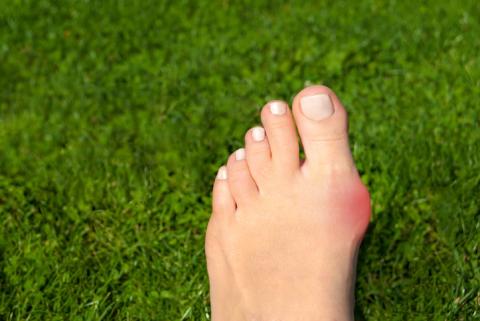Goodbye Sandals, Hello Bunion Pain
Podiatrists report that autumn brings an increase in patients coming in with foot pain—specifically, the pain caused by bunions.
Why? According to the American College of Foot and Ankle Surgeons (ACFAS), it’s because people, especially women, often wear sandals and other lighter shoes all summer. When the temperature drops, out come the enclosed-toe shoes—and bunion pain and inflammation. For example, South Carolina foot surgeon Dr. Michelle Butterworth reports that she sees a lot of teachers who have “back-to-school bunion pain.”
That makes fall a good time to talk to a doctor if you’re suffering from this common condition, which can be painful and even debilitating.
Bunions are bony bumps that form on the side of the foot at the base of the big toe. A person can develop a bunion at any age, but bunions often worsen as we use our feet over the years. Bunion pain is ten times more common in women, caused no doubt by the shoes they wear. Arthritis also raises the risk. Bunions can cause seniors to adopt a sedentary lifestyle: if it hurts to walk, we’re less likely to do so!
Foot health experts recommend having bunions evaluated as soon as possible. Treatment might include:
Foam or gel padding, orthotics (shoe inserts) and splints. These should be properly fitted so as not to increase pressure on the bump.
Anti-inflammatory medications and injections. These can relieve pain and swelling, and reduce underlying arthritis.
Ice packs, ultrasound and massage. These hands-on techniques may provide pain relief and reduce irritation. Follow the doctor’s instructions for icing at home.
A “prescription” for the right shoes. Avoid wearing pointy, triangular shoes. Instead, choose footwear with wide and adequate toe room, a flexible sole and sturdy heels—no more than an inch high. A shoe repair shop can sometimes use a stretcher to modify the area of the shoe that is putting pressure on a bunion. And remember, our shoe size changes as we grow older. If you’re still wearing the size you wore 20 years earlier, your shoes are likely too small.
Bunion surgery. The above techniques can reduce pain, but in many cases, surgery is necessary to correct the deformity. Bunion surgery can make a big difference. Dr. Butterworth says, “Probably the biggest thing is, they think surgery’s not going to work and the bunion will come back. It’s probably the biggest myth I dispel.” But an ACFAS member from New York, Dr. Michael Loshigian, warns, “If wearing four-inch heels and working on your feet all day wasn’t good for you before the surgery, it’s certainly not going to be good for you after the surgery.”
